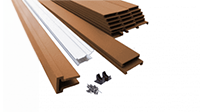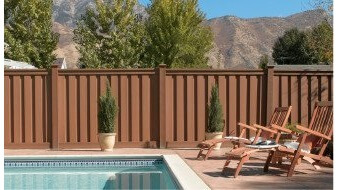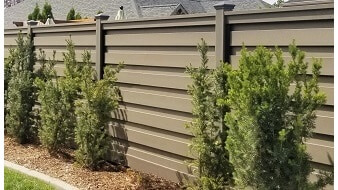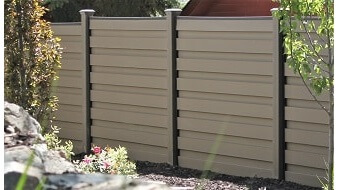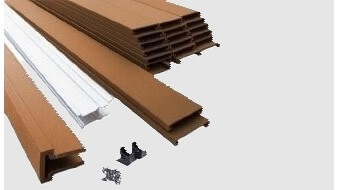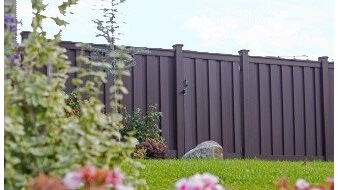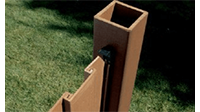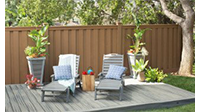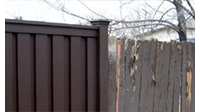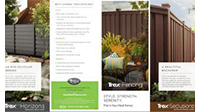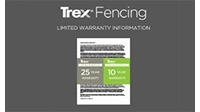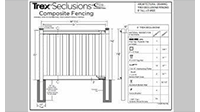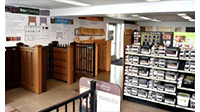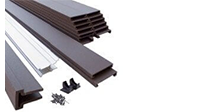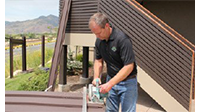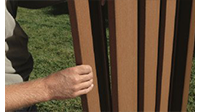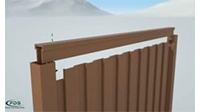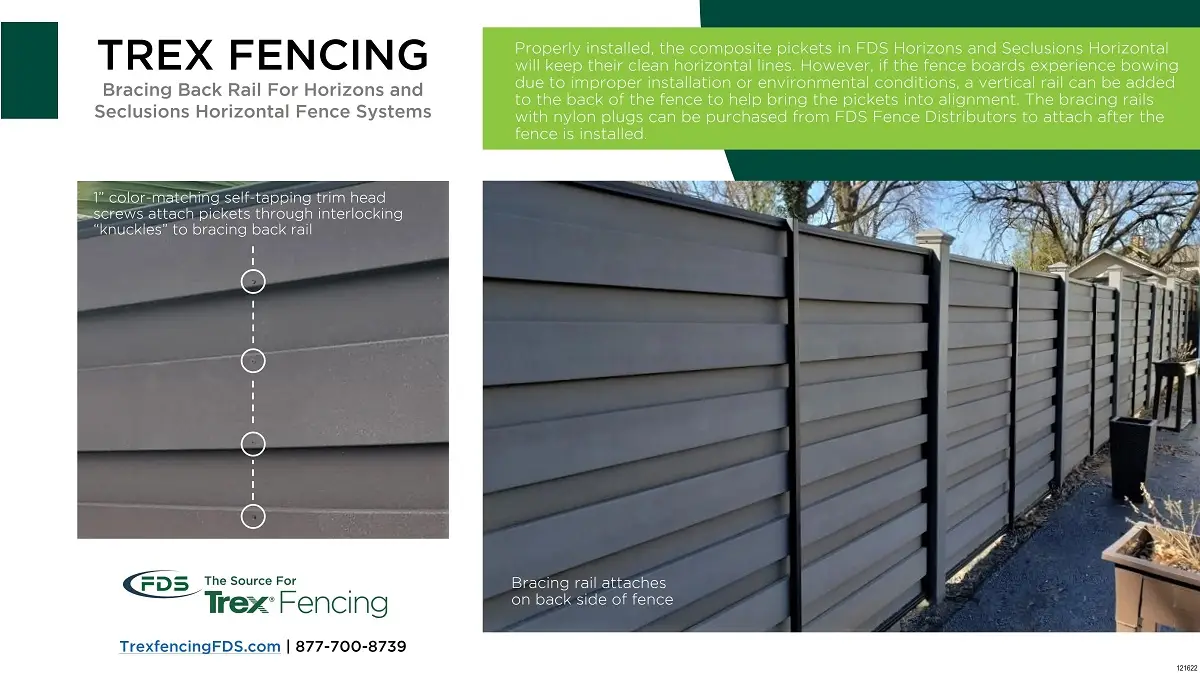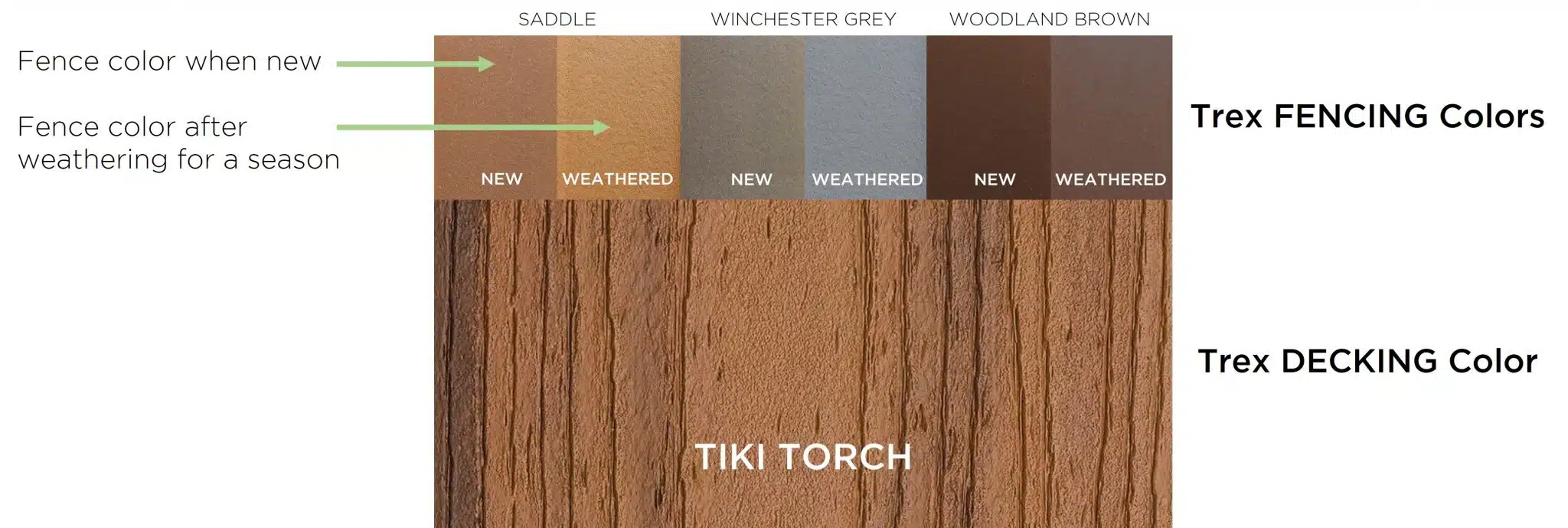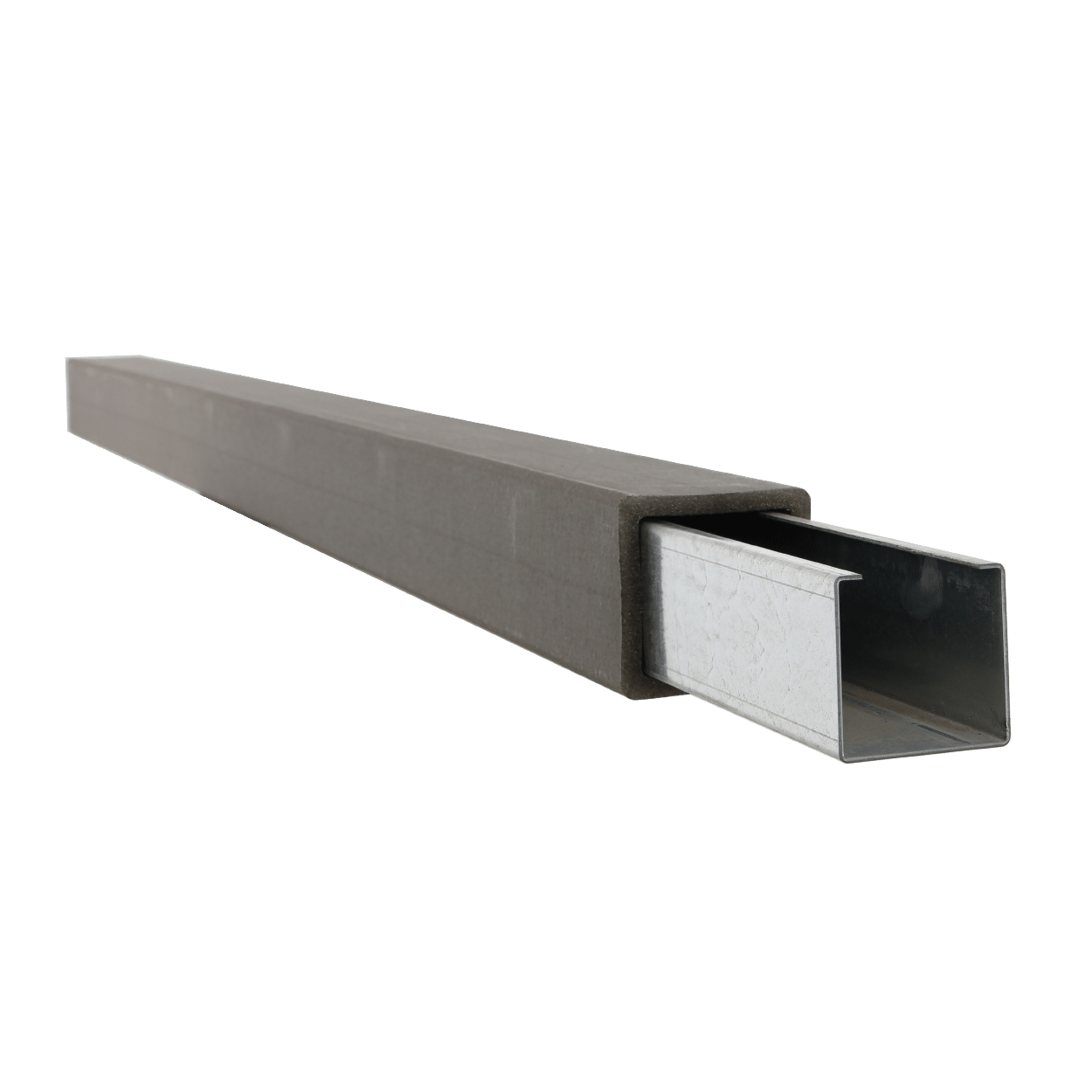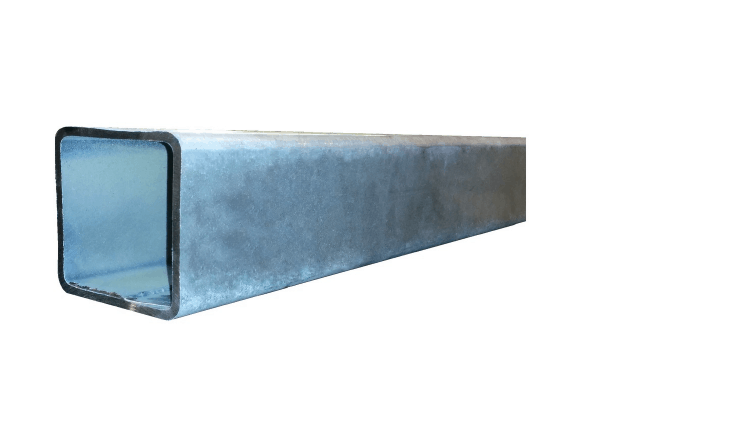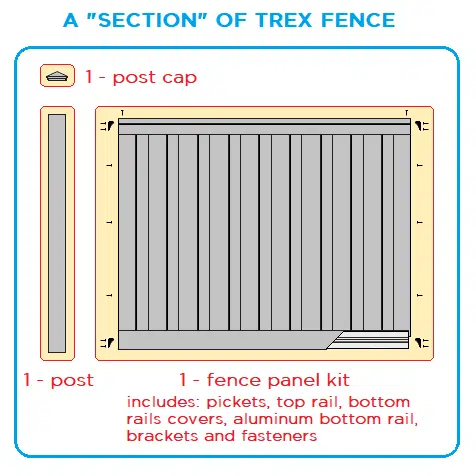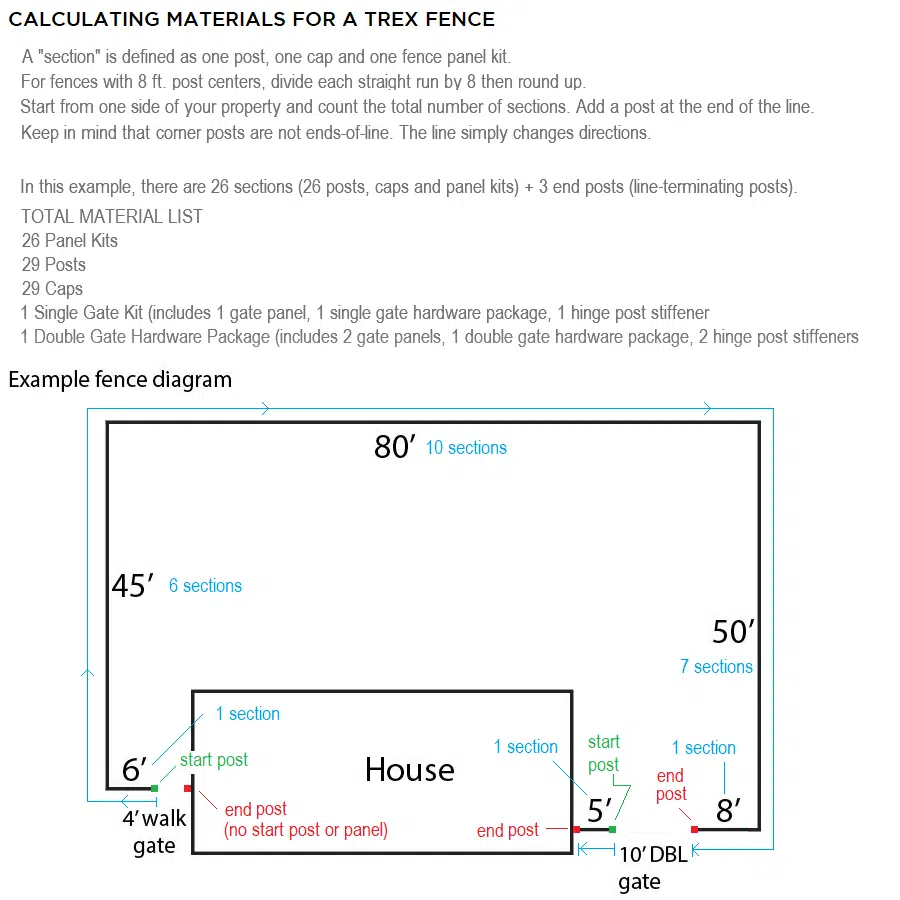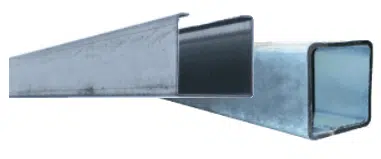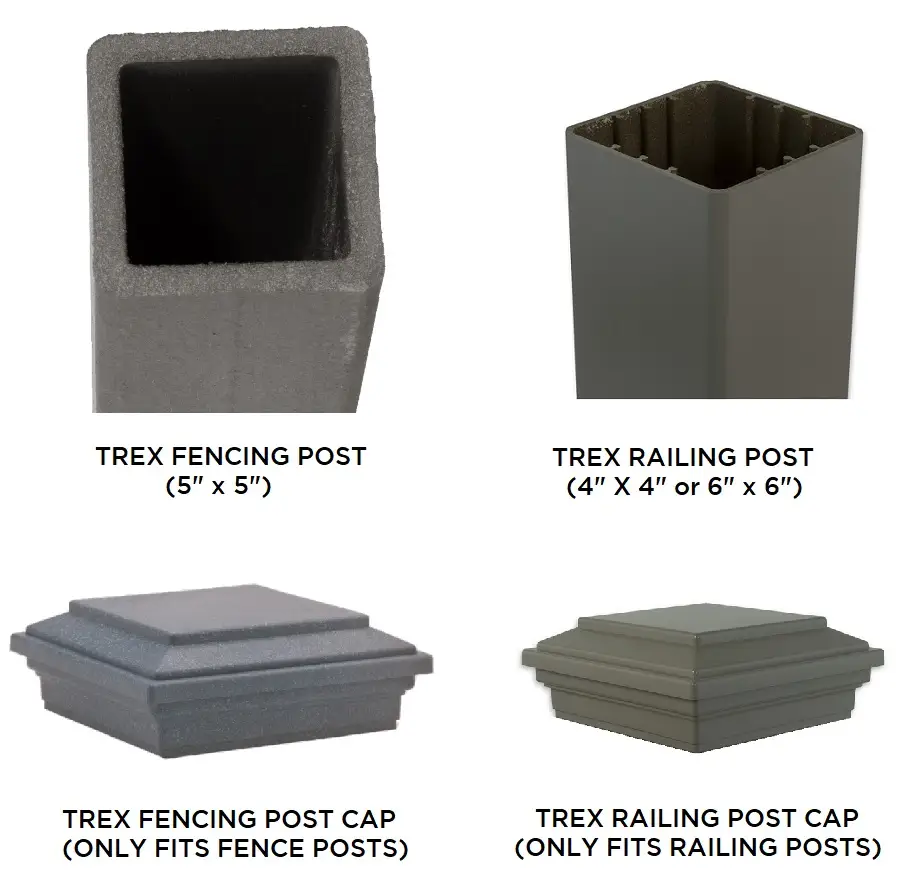Are Heavy Duty Hinges Available?
FDS Distributors offers heavy duty hinges for large gates fabricated by FDS. Our standard hinges will work for all gate up to 6′ tall in standard and large widths. We recommend heavy duty hinges for gate panels over 65-1/2″ wide or for any width for gates over 6′ tall.
The FDS Heavy Duty Hinge is sold in sets of two. The hinges are made of black power-coated stainless steel (some parts of the hinge are not black coated). They are not self-closing.
Note: All Trex gate hardware sold by FDS are compatible with FDS-fabricated gates and Trex composite 5″ x 5″ composite fence posts. They may not be compatible with other products. Trex fence posts used for the hinge side of a gate should always have a steel post stiffener inside. With heavy duty hinges, a 3.5″ x 3.5″, 7-gauge square tube stiffener should be used (available from FDS).
Our Heavy Duty Hinge (part number TrexHinge-HD)

How do I fix bowing or warping in my horizontal fence?
As discussed in other articles, one of the challenges of any horizontal fence, whether wood, plastic, or composite, is making sure the rails stay true both vertically and horizontally. The Horizons (and, similarly, Solitudes) fence system takes advantage of the metal frame components and interlocking design to keep the pickets from distorting. However, improper installation or high humidity and heat may cause the pickets to swell, which can cause bowing. There are a few essential steps and remedies to deal with this issue.
Pre-installation considerations to avoid bowing
Shorter Post Centers
For installations in high heat and humidity, if you have not yet finalized your project plan and purchase, consider shortening the width of the sections. The shorter the distance between the vertical posts, the lower the possibility of picket flexing, and if the pickets do bow, it will be less noticeable.
Preventative measures during installation
Leaving gaps to allow for expansion
If you have already purchased your materials, be sure to follow the instructions regarding expansion as as noted in the installation guide. A gap of at least 3/8″ of an inch on each side of the fence panel is necessary to allow the pickets to expand (reference Step 7B in the installation guide). Since the post centers are 97″ (and therefore 92″ between posts), typically there will be sufficient room for the standard 91″ board to fit with gaps without trimming. However, extruded composite material like Trex pickets can vary slightly in length and therefore may not be exactly 91″, so check the measurements of your pickets before installing them to make sure they are no more than 91″ in length. If you are installing the fence in cold dry weather, bear in mind that even though the pickets may have sufficient room now, in hot and humid weather they may not.
Ensuring pickets interlock
Trex pickets are designed to interlock. This not only gives the fence its unique design and added strength, it also helps the pickets keep their form. Therefore, if the bottom picket sits too high and cannot interlock, some adjustments will be necessary. First, evaluate if you can achieve the results you are looking for by using fewer pickets. If fewer pickets gives you too much of a gap under the fence, you can rip the last picket to make sure the top of the bottom picket interlocks with the picket above it (be sure ALL pickets interlock). You should never rip any picket except the one at the bottom of the fence. This picket will be screwed to the metal horizontal bottom rail which will give it the rigidity lost by ripping the bottom edge off the picket. Here is what the bottom rail will look like after ripping the bottom and screwing it to the Horizons bottom rail. Your measurements will vary depending on how much room is left at the bottom after installing all the remaining pickets. Keep in mind that it is best to have approximately 1″ of clearance at the bottom to avoid constant contact between the ground and the metal bottom rail. If the fence is installed in an area with water-saturated soil that is likely to heave and come in contact with the bottom of the fence, consider a bigger gap underneath.
Our Horizons Installation Guide provides more details in regards to general installation, measurements, instructions, etc.
Resolving bowing if the fence is already installed
If the fence was not installed properly and the pickets have bowed because the boards weren’t cut to provide the necessary expansion gaps or the pickets are no longer interlocked, the fence may need to be unassembled to allow reinstall correctly. Usually, only Steps 7B through 9 are necessary, although it may also be necessary to rip the bottom picket as described in the section immediately above this one.
If the Horizons fence pickets won’t relax after the boards are cut to allow for the necessary gaps (permanent deformation may occur if the pickets have been bowed for an extended period of time), a vertical back bracing rail can be applied. This component helps to bring the pickets back into alignment. On the back side of the fence, screw the bracing rail to the top and bottom Horizons horizontal rails. Then, fasten screws from the other side through the composite pickets into the back bracing rail. To make sure you screw through the pickets into the back bracing rail, temporarily attach a string to the middle of the to top rail and pull it tight over the front of the fence panel, then pull the string through the bottom and attach it in the middle of the bracing rail at the bottom of the fence. This creates a straight line that you can use as your guide to fasten the screws. Only fasten the screws through the pickets that touch the back bracing rail. Use self-tapping screws with color matching heads for best results (FDS can supply these with the back bracing rail upon request).
Part Numbers for Vertical Back Bracing Rail application:
- TFHMSB-8 = Vertical Back Bracing Rail (Vendor description: “Horizons Mid Span Brace Black”)
- TFHMSB-Cap = Caps for Back Rail
- Screws: DFES350JB = Woodland Brown, DFES350GY = Winchester Grey, DFES350BN = Saddle
- Paint-Textured = Paint to touch up any exposed metal
Where is the steel frame inside the FDS pre-built gate?
The galvanized steel frame is situated 1″ in from the edge of Trex gates built by FDS Distributors. The frame is 1-1/4″ steel tube, so the center point is 2-5/8″ in from the edge of the gate. When attaching hardware, whether parts from the FDS gate packages or third-party products you will apply after the fact, be sure to attach into the frame with self-tapping screws. The composite is not meant to suppor the function of hinges, latches or other gate components. Here is an cutaway illustration of the interior of the gate.
Does Trex make lattice panels?
Trex does make a lattice. Trex’s licensed partner, Acurio Latticeworks, manufactures a lattice system that can be used for a variety of purposes in conjunction or separately from Trex’s other products. For example, like other types of lattice panels, Trex Latticeworks can be added to a Trex fence to create a beautiful semi-privacy design. A popular style is full privacy at the bottom of the fence panel using Trex’s standard pickets and rails, then lattice privacy panel between a mid-rail and the top rail. Trex Latticeworks can be cut to fit sections of whatever length is needed and it comes in a variety of heights. While Trex lattices cannot be ordered from us, you can visit Trex LatticeWorks for more information.
Looking for ideas on how build Trex Fencing with lattice panels? See the link to a related article with a suggestion for a lattice installation concept.
Can I put lattice on top of my Trex Fence?
Many customers want to put a decorative piece on top of their fence, such as lattice of some kind. While we do not offer any of those products, decorative pieces can be added to compliment your Trex Fence with some creativity. You can view our Gallery to see some of the creative ways customers have customized our fencing. Trex does offer Lattice panels that can be ordered separately as well.

How to make a lattice panel on top of my Trex Fence
Here is a concept on how to add a lattice panel to your Trex Fence. Using a second top rail, two additional bracket, and pieces cut from extra pickets, you, could easily build this design.
Instructions:
Decide on the height of the panel you want and purchase your own panels accordingly. We suggest using a lattice panel that is no thicker than 1/4″ so you can use pieces of Trex pickets to wedge the panel into place.
Build the privacy portion of the Trex fence by cutting down the pickets to the desired height. Finish off the pickets with a top rail which will serve as your mid rail.
Rip cut the “knuckles” off extra pickets. You will use these as supports to sandwich the lattice panel on top of the mid-rail and to wedge the lattice panel inside the top rail channel.
Place the top rail over the lattice and secure every in place with finish nails or trim head composite screws.
Note: since a customer would be combining a self-sourced third-party product with Trex and ultimately devising their own design, this is offered as a suggestion only to give the customer an idea of a potential method of building a Trex fence with lattice panels.
Do you have steel post stiffeners with base plates?
While Trex posts are designed to be stand-alone posts in most applications, there are certain scenarios in which a steel reinforcement would be necessary and recommended. For instance, we recommend using a post stiffener when a Trex gate is going to be hung off of a post. Another common scenario is when customers are wanting to mount Trex Fencing onto a concrete pad, wall, or their deck/patio. In these cases, we offer post stiffeners of various sizes that include a welded base plate so that the stiffener can be anchored to the concrete.
The size of fence you are mounting will determine how heavy duty of a stiffener is needed.
- For a 6’H fence, consider our standard galvanized 24” mount with 3.5” x 3.5” base plate and holes that are 9/16” in diameter *
These mounts work fine as long as the fence is not being installed in a high wind area. We do, however, offer stiffeners that are heavier duty to support fences that are either a) in high wind areas or b) taller than 6’H. Due to the sheer weight and size of a fence at those heights, you are going to want a post stiffener that can successfully provide structural support.
For these types of scenarios, we offer heavy duty 7 gauge post stiffener with a welded base plate to anchor the stiffener to the concrete. These post stiffeners are the same as the ones we use for our large gates. They are different from our C-channel 12 gauge stiffeners that are used for our standard gates.
- The galvanized heavy duty post stiffener comes in either 108” or 144” heights, and are 3.5” x 3.5” *
- The galvanized plate that is welded to the base of the stiffener is 8” x 8” and is 3/4” thick. The plate holes are 3/4” in diameter and fit a 5/8” anchor *
Heavy duty stiffeners with base plates are not available to order on our website, but can be ordered by calling and ordering over the phone with one our sales associates at 877-700-8739. Our sales team members are also technical experts and can help answer any questions you have for your project, including how to make sure your fence is installed in a way to ensure structural integrity.
* Note: Steel post stiffeners and the base plate installation methodology are not included in standard installation guidelines and are not covered by warranty.
Find complementary Trex fencing and decking colors
What color in the fencing line pairs best with your Trex deck? That depends on your style sensibilities, but we’re here to help you make an informed decision. Visit our Complementary Colors page to see color swatches with each decking color next to the three fencing colors (both before and after weathering). Order samples for an even better side-by-side comparison.
How do I clean sap off my fence?
How do you clean a Trex fence?
Typical cleaning of a dirty Trex fence usually only requires using a bucket of soapy water, a soft bristle brush, and a hose. The dirt usually comes off easily and the fence looks fantastic after the cleaning. Some foreign materials such as graffiti or sap may take more effort to clean. Importantly, we do not recommend pressure washing the fence as that will likely damage the fence. Consult the Trex Fencing Care and Cleaning guide for more advice on cleaning a dirty fence.
What are steel post stiffeners?
Trex Fencing posts typically do not need stiffeners or inserts. The exceptions would be for fences taller than 8′ and for the hinge side of a gate. Two types of post stiffeners are used with Trex fencing and gates.
C-Channel Hinge Post Stiffener (TPFI)
This stiffener is designed for use with gates up to 6′ tall and widths up to the Large Standard size (65-1/2″ wide), and that have a fence section on the opposite side of the gate hinge post*. One end is open to allow the brackets for a section of fence to be attached on the opposite side without interference. The 12-gauge galvanized steel is available in 9′ lengths.
* A section of fence on the opposite side of the hinge post helps to keep the hinge post plumb by acting as a counter balance).
Heavy Duty Post Stiffener (TPFIHD and TFPIHD12)
This stiffener is used for large gates, fences taller than 8′, when the hinge post is a standalone post, and when a fence line does not run parallel on the opposite side of the hinge post.
The heavy duty stiffener can be embedded in a concrete pad with the Trex composite post sleeved over the top. The 7-gauge (.188″ thick”) square tube is made of galvanized steel. Note, a ring is welded inside the square tube. This does not serve any purpose for the installation of a Trex fence. It is used to hang the tube as it is dipped for galvanization. The heavy duty stiffeners are available in 9′ (TFPIHD) and 12′ (TFPIHD12) lengths. Self-tapping screws will need to be used when attaching fence brackets (if applicable) to the hinge post.
Note: Heavy duty hinges are available for gates larger than 6′ wide and with heights more than 6′ tall.
How do I figure how much material I need for my fence?
Figuring or calculating your materials isn’t hard if you understand the basics of how to create a layout and use your measurements. With any fence, including Trex, the general principle of figuring out how many posts, rails, pickets, etc., is as follows:
A “section” of fence is defined as a post (and cap) and all of the materials you need before the next post. With Trex, it’s easy, we sell materials as unassembled “kits” so everything you need between the posts is included.
Here are two images that will give you instructions on how to figure how much material you need for your property.
Can I use a Trex post as a sleeve?
Unlike wood fence posts, Trex is hollow in the center and has a wide enough dimension to use the Trex post as a sleeve. The post is designed to be a self-supporting component so it wouldn’t be necessary to reinforce them, except where applicable*, but the hollow post allows it to be used interchangeably as a sleeve.
A Trex post has an outer dimension of 5″ x 5″ with a 5/8″ wall. The inner dimension is 3-3/4″ x 3-3/4″ which is wide enough to allow the Trex post to sleeve over most nominal 4″ x 4″ posts or a steel pole. This design gives a consumer a lot of options for installation. A Trex post can sleeve over a pressure treated wood post on a deck which would then allow a builder to cut the panel kit components to create a privacy railing or screen. A Trex post could be sleeved over galvanized steel posts embedded into a concrete wall or pad so the fence would be built on top without having to core out a hole for the post. A Trex post could be sleeved over a 4×4 structural support post for a deck before the deck is built to provide a much more attractive and thicker looking post than the wood inside. NOTE: Trex Fencing posts are not the same as railing posts. The components are not compatible with each other. Search for article on railing sleeves.
Learn more about Trex Fencing posts.
* Trex posts used to mount hinges for a gate require a steel post stiffener. Gates made from Trex composite components are heavy and because they move, there is significant torque on the posts used to attach hinges. Additionally, stiffeners are necessary for fences over 8′ tall to extend the depth of the post hole sufficiently to support a tall fence.
Is there a warranty on the Trex Gates?
Trex’s 25-year residential warranty does not cover our Trex gates and hardware as a whole, as there are metal components that are not comprised of Trex composite material, and are thus cannot be vouched for by Trex. However, the individual composite pieces of the gate are covered under the terms of the warranty.
For example, a gate hinge that breaks would not be covered under warranty. Neither would latches or handles that break due to either excessive abuse or natural wear and tear.


Are Trex Fencing Posts the same as Trex Railing Posts?
The Trex railing sleeves are not the same product as the fence posts. The Trex railing sleeves are a plastic-heavy composite that look more similar to a vinyl material than the Trex composite material used for the fencing and the core of the decking products. The railing components are used strictly as sleeves (sliding over 4×4 or 6×6 nominal posts attached to a deck). They cannot be used as standalone posts, whereas the Trex Fencing post is meant to be a self-supporting component. The hollow cavity of the Trex Fencing post does give it the ability to be used as a sleeve if needed such as to allow the insertion of a steel post stiffener for gate hinge posts.
PLEASE NOTE: We are the distributor for Trex Fencing only. Our team is not able to answer questions about the railing components or systems. Please contact 800-289-8739 to speak directly to a Trex representative or contact your local decking and railing supplier.
Does the color of a Trex Fence fade or have variation?
The color of Trex Fencing fades to a degree through a natural weathering process. Color fading in general is a well known phenomena that occurs when plastic and pigments are exposed to UV light. To counter the full impact of sunlight, the product is over-pigmented during manufacturing and engineered to maintain pigmentation throughout its life. As a result of this practice, the fencing arrives significantly darker and in a different hue than it will be once it has had an opportunity to weather (this is particularly noticeable in Winchester Grey which has a brownish color when it is new). Trex engineers have worked with pigmentation over the years to set a specific color value during production to allow the product to fade from its original color to an intended lighter color which is still vibrant, attractive, and natural looking.
The majority of the fading typically takes a season of exposure to the sun. After initial weathering has occurred, any additional fading is minimal and Trex will retain color throughout its life. You can learn more by visiting Trex Fencing Colors on our website.
Note regarding variation: Some variation may exist between the individual components. This occurs because the recycled material in Trex composite comes from a variety of sources and can interact differently with the pigmentation. Variation is not considered a manufacturing defect and is not covered under warranty. To learn more, see our Trex Fencing Colors page. If you prefer to minimize variation, group pickets of similar hues.
Note regarding post caps:



